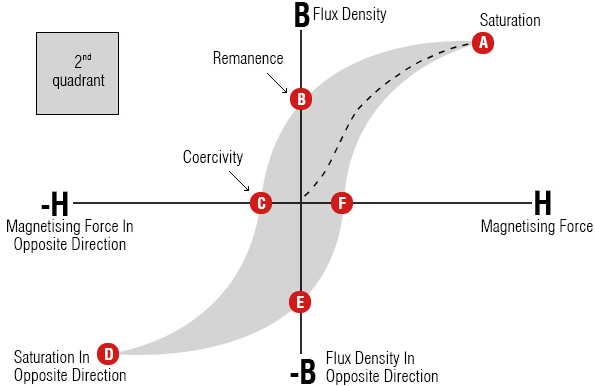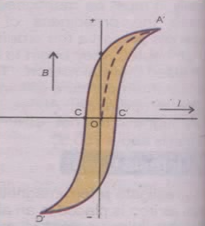The value of flux density for any value of current is always greater when the current is decreasing, then when it is increasing magnetism lags behind the magnetizing current. This process is known as hysteresis.
Hysteresis Loop definition
To investigate a ferromagnetic material, a bar of that material such as iron is placed in an alternating current solenoid.
When the alternating current is at its positive peak value, it fully magnetizes the specimen in one direction and when the current is at its negative peak, it fully magnetizes it in the opposite direction.
Thus as the alternating current changes from its positive peak value to its negative peak value and then back to its positive peak value, the specimen undergoes a complete cycle of magnetization.
The flux density versus the magnetization of the specimen for the various value of the magnetizing current of the solenoid is plotted as a CRO.
Its main features are the following:
1. Hysteresis
The portion of OA of the curve is obtained when the magnetizing current I am increased and AR is the portion when the current is decreased. It may be noted that the value of flux density of any value of current is always greater when the current is decreasing than when it is increasing, i.e., magnetism lags behind the magnetizing current. This phenomenon is known as hysteresis.
2. Saturation
The magnetic flux density increases from zero and reaches a maximum value. At this stage, the material is said to be magnetically saturated.
3. Remanence or Retentivity
When the current is reduced to zero, the material still remains strongly magnetized represented by point R on the curve. It is due to the tendency of domains to stay partly in line, once they have been aligned.
4. Coercivity
To demagnetize the material, the magnetizing current is reversed and increased to reduce the magnetization to zero. This is known as coercive current represented by C on the curve. The coercivity of steel is more than that of iron as more current is needed to demagnetize it. Once the material is magnetized, its magnetization curve never passes through the origin. Instead, it forms the closed-loop ACDC’A, which is called the hysteresis loop.

5. Area of the Loop
The area of the loop is a measure of the energy needed to magnetize and demagnetize each cycle. This is the energy required to do work against the internal friction of the domains. This work, like all work that is done against friction, is dissipated as heat. It is called hysteresis loss.
Hard magnetic materials like steel can not be easily magnetized or demagnetized, so they have a large loop area as compared to soft magnetic material such as iron which can easily be magnetized. The energy dissipated per cycle, thus, iron is less than steel.
The suitability of magnetic materials for different purposes can be studied by taking the specimen through a complete cycle and drawing the hysteresis loop. A material with high retentivity and large coercive force would be most suitable to make a permanent magnet. The cores of electromagnets used for alternating currents where are specimen repeatedly undergoes magnetization and demagnetization should have narrow hysteresis curves of the small area to minimize the waste of energy.
For related Topics visit our Page: Electricity and Magnetism